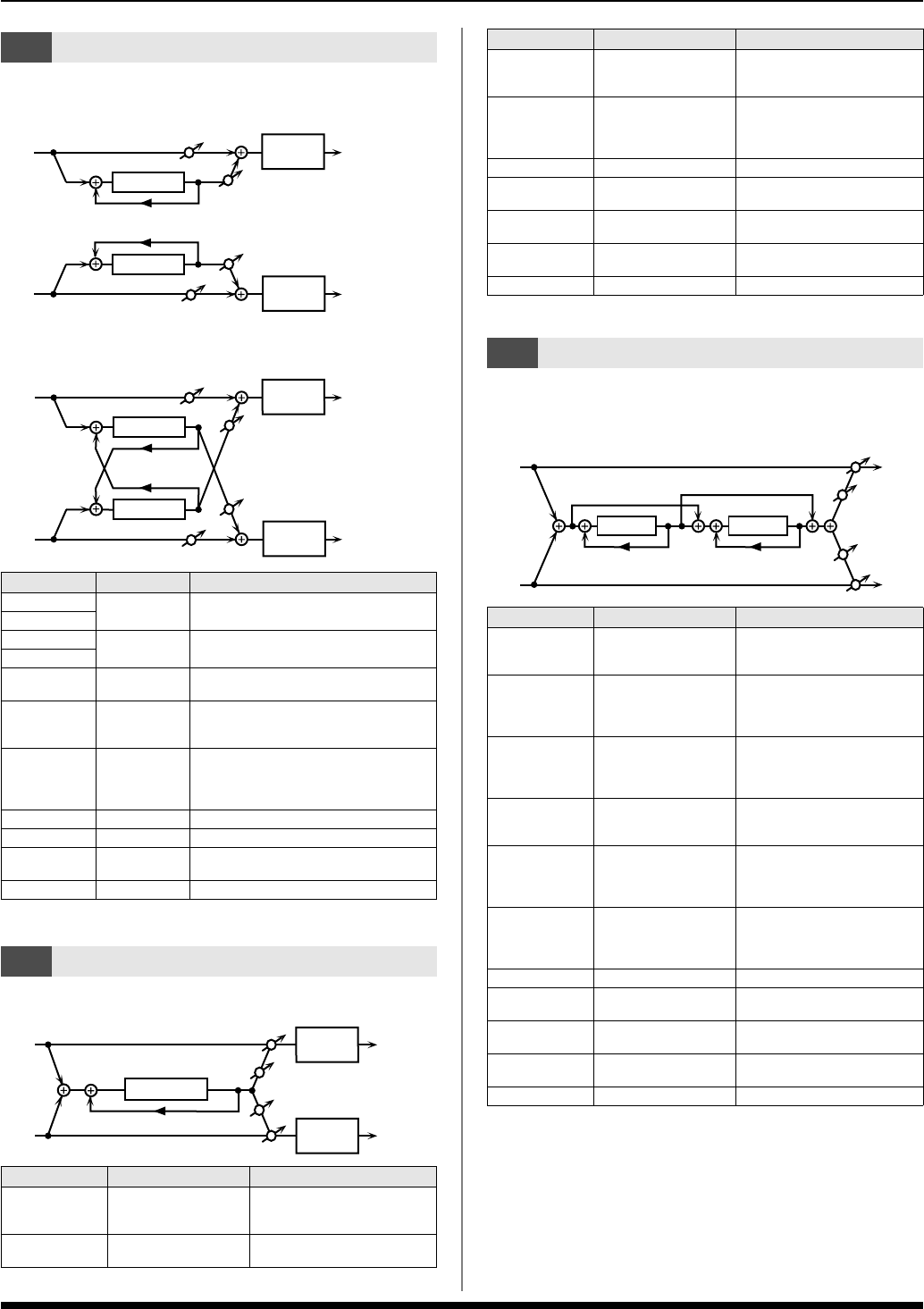
71
This is a stereo delay.
When Feedback Mode is NORMAL:
fig.MFX-43a
When Feedback Mode is CROSS:
fig.MFX-43b
A delay that provides a long delay time.
fig.MFX-44
This delay connects two delay units in series. Feedback can be
applied independently to each delay unit, allowing you to produce
complex delay sounds.
fig.MFX-45
43: DELAY
Parameter Value Description
Delay Left
0–1300 ms,
note
Adjusts the time until the delay sound is
heard.
Delay Right
Phase Left
NORMAL,
INVERSE
Phase of the delay sound
Phase Right
Feedback
Mode
NORMAL,
CROSS
Selects the way in which delay sound is fed
back into the effect. (See the figures above.)
Feedback -98– +98%
Adjusts the amount of the delay sound that’s
fed back into the effect. Negative
(-) settings invert the phase.
HF Damp
200–8000 Hz,
BYPASS
Adjusts the frequency above which sound fed
back to the effect is filtered out. If you don’t
want to filter out any high frequencies, set this
parameter to BYPASS.
Low Gain -15– +15 dB Gain of the low frequency range
High Gain -15– +15 dB Gain of the high frequency range
Balance
D100:0W–
D0:100W
Volume balance between the direct sound
(D) and the delay sound (W)
Level 0–127 Output level
44: LONG DELAY
Parameter Range Explanation
Delay Time 0–2600 ms, note
Delay time from when the origi-
nal sound is heard to when the
delay sound is heard
Phase NORMAL, INVERSE
Phase of the delay (NORMAL:
non-inverted, INVERT: inverted)
R in
R out
L in
L out
Feedback
Feedback
Balance W
Balance D
Balance W
Balance D
2-Band
EQ
2-Band
EQ
Delay
Delay
R in
R out
L in
L out
Feedback
Feedback
Balance W
Balance D
Balance W
Balance D
2-Band
EQ
2-Band
EQ
Delay
Delay
L in
R in
L out
R out
2-Band
EQ
Pan R
Pan L
2-Band
EQ
Feedback
Long Delay
Feedback -98– +98%
Proportion of the delay sound
that is to be returned to the input
(negative values invert the phase)
HF Damp
200–8000 Hz,
BYPASS
Frequency at which the high-fre-
quency content of the delayed
sound will be cut (BYPASS: no
cut)
Pan L64–63R Panning of the delay sound
Low Gain -15– +15 dB
Amount of boost/cut for the high-
frequency range
High Gain -15– +15 dB
Amount of boost/cut for the high-
frequency range
Balance D100:0W–D0:100W
Volume balance of the original
sound (D) and delay sound (W)
Level 0–127 Output volume
45: SERIAL DELAY
Parameter Range Explanation
Delay1 Time 0–1300 ms, note
Delay time from when sound is
input to delay 1 until the delay
sound is heard
Delay1
Feedback
-98– +98%
Proportion of the delay sound
that is to be returned to the input
of delay 1 (negative values invert
the phase)
Delay1 HF Damp
200–8000 Hz,
BYPASS
Frequency at which the high-fre-
quency content of the delayed
sound of delay 1 will be cut (BY-
PASS: no cut)
Delay2 Time 0–1300 ms, note
Delay time from when sound is
input to delay 2 until the delay
sound is heard
Delay2
Feedback
-98– +98%
Proportion of the delay sound
that is to be returned to the input
of delay 2 (negative values invert
the phase)
Delay2 HF Damp
200–8000 Hz,
BYPASS
Frequency at which the high-fre-
quency content of the delayed
sound of delay 2 will be cut (BY-
PASS: no cut)
Pan L64–63R Panning of the delay sound
Low Gain -15– +15 dB
Amount of boost/cut for the low-
frequency range
High Gain -15– +15 dB
Amount of boost/cut for the high-
frequency range
Balance D100:0W–D0:100W
Volume balance of the original
sound (D) and delay sound (W)
Level 0–127 Output volume
Parameter Range Explanation
R in
R out
L in
L out
Feedback 1
Pan L
Pan R
Delay 1
Feedback 2
Delay 2
Prelude_e.book Page 71 Wednesday, January 14, 2009 2:18 PM


















